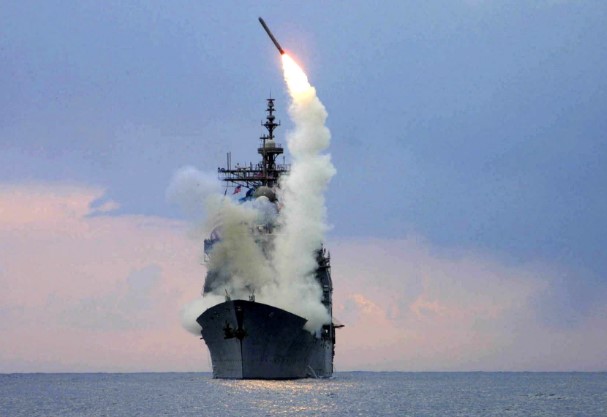The United States is considering supplying Ukraine with Tomahawk cruise missiles, a move that could change the dynamics of the ongoing conflict with Russia. Tomahawks are long-range missiles, propelled by jet engines and guided by on-board GPS systems. They are made by the American defense company Raytheon and are currently used by militaries in the US, UK, Australia, and the Netherlands. Each missile costs around $1.3 million, roughly £973,000.
What Are Tomahawk Missiles and Why Ukraine Wants Them
Measuring about 6 meters (20 feet) in length, the Tomahawk carries a 1,000-pound (450kg) warhead and has an onboard camera that allows operators to observe targets. Some of the latest versions can “loiter” near a target, waiting for the right moment to strike, and can even switch targets mid-flight if circumstances on the ground change.
Experts highlight the missile’s flexibility and precision. Professor Michael Clarke, a defense analyst, explained that the Tomahawk allows for “dynamic targeting,” meaning operators can make last-minute decisions to strike moving or high-value targets. Its subsonic speed and low-altitude flight make it extremely difficult for ground radar to detect, even in heavily defended areas.
Kremlin threatens retaliation as U.S. mulls sending Tomahawk missiles to Ukraine
Ukraine has already been using weapons like the British Storm Shadow missile and the US Army Tactical Missile System (ATACMS). However, these have a much shorter range of 150-200 miles, limiting Ukraine’s ability to target deep inside Russian territory. Tomahawks, with a range of about 1,500 miles, could significantly expand the scope of Ukraine’s potential strikes.
Typically, militaries launch Tomahawks from ships or submarines, but Ukraine may need to fire them from land. The American Typhon missile system can perform this, though it remains unclear whether Ukraine will receive this system or use another solution. The US first used Tomahawks during the Gulf War in 1991, and US and UK forces have recently employed them against Houthi rebels in Yemen.
Potential Impact on the War
It is still uncertain how decisive Tomahawks would be in the conflict. Some analysts suggest they would provide Ukraine with “very valuable” firepower but are unlikely to completely change the course of the war. Alistair Bunkall, Sky News’ foreign correspondent, said their main benefit would be enabling Ukraine to strike key Russian infrastructure located deep within Russian territory.
Professor Clarke explained that Ukraine would probably use the missiles to target transport choke points, military depots, and factories producing drones that threaten Ukrainian skies. Key targets could include oil depots, railway yards, stationary vehicle convoys, and other logistical nodes behind the frontline. These are locations that cannot easily be captured or destroyed by conventional weapons.
Across party lines: Americans unite to arm Ukraine and tighten sanctions on Russia
Experts also caution against targeting Moscow directly. Professor Clarke described such a move as “pointless” and “foolish,” unless Ukraine’s goal was purely political, which could backfire. However, the fact that Russia has repeatedly commented on the potential supply of Tomahawks suggests that they see the missiles as a serious threat.
“Russians are clearly concerned about Tomahawks. They carry a heavy warhead, are extremely accurate, and are hard to defend against,” said Clarke. “Ukrainians could use them to disrupt the creeping offensive the Russians have maintained throughout the year.”
Russian Reactions and Diplomatic Tensions Over Tomahawk Missiles
Russian officials have publicly expressed concern about the possible supply of Tomahawks. Kremlin spokesperson Dmitry Peskov acknowledged that while the missiles would not directly change frontlines, their presence is a “serious escalation.” Peskov noted that some Tomahawk variants can carry nuclear warheads, which adds an extra layer of caution for Moscow.
“Imagine a long-range missile is launched and could be nuclear. How should Russia react?” Peskov asked during a Russian state TV interview. Former Russian president Dmitry Medvedev also commented, describing the potential supply as dangerous and expressing hope that the US threat would remain “empty.”
Meanwhile, US President Donald Trump has indicated he may approve the missile supply during a meeting with Ukrainian President Volodymyr Zelenskyy. Trump described the Tomahawk as an “incredible weapon” that Russia “does not need” and suggested he might issue it as leverage if the war does not end. He emphasized that the decision could be used to apply pressure but also left the possibility open to hold back the missiles.
Trump makes Tomahawk joke with Argentina leader during economic and military discussion
Senior Ukrainian officials have already met with American weapons manufacturers, including Raytheon, in Washington, signaling a strong interest in acquiring the missiles. President Zelenskyy has described obtaining Tomahawks as “significant” and indicated he had provided a clear vision of the quantity Ukraine would like to acquire.
The discussion surrounding Tomahawks highlights the increasing intensity of the conflict, as well as the high stakes for both Ukraine and Russia. While the missiles could significantly expand Ukraine’s strike capabilities and allow Ukrainian forces to disrupt Russian operations behind the frontline, experts widely consider striking major cities like Moscow impractical and politically risky.

